A team of scientists organized and led a team of university and government researchers on an Arctic expedition.
A team of scientists organized and led a team of university and government researchers on an Arctic expedition.
The expedition was to initiate methane hydrate exploration in the Beaufort Sea and determine the spatial variation of sediment contribution to Arctic climate change.The team was from the Marine Biogeochemistry and Geology and Geophysics sections of the Naval Research Laboratory (NRL).
Utilizing the US Coast Guard Cutter Polar Sea as a research platform, three cross-shelf transects were surveyed and sampled off Alaska's North Slope at Hammerhead, Thetis Island and Halkett representing three regions of the Alaskan shelf.
The expedition integrated expertise in coastal geophysics, sediment geochemistry, dissolved and free methane fluxes through the water column and into the atmosphere, sediment and water column microbiology and biogeochemistry and detailed characterization of the sub-seafloor geology.
"The objective of the sampling is to help determine variations in the shallow sediment and water column methane sources, methane cycling and the subsequent flux to the atmosphere," said Richard Coffin, chief scientist, NRL Chemistry Division.
The content, location and distribution of methane in hydrate is variable and controlled by geothermal gradients and biological and thermal methane production.
Advertisements
International research has begun with a primary goal of obtaining the methane in these hydrates as an energy source.
Advertisements
Regions selected for this study were based on the review of Minerals Management Service and US Geologic Survey (USGS) seismic data with specific sample locations decided on board through review of the 3.5 Kilohertz (kHz) sub-bottom profiler data.
The MITAS-1 crew focused on goals like, to acquire and integrate seismic, acoustic, temperature, geochemical, and lithostratigraphic data for evaluation of deep sediment hydrate distributions.
The team aimed to determine and model the transport of methane from the sediment through the water column into the atmosphere.
It also aimed to study the control of total methane emissions by microbial methane consumption in the sediment and in the water column.
Source-ANI
ARU






